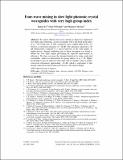Files in this item
Four-wave mixing in slow light photonic crystal waveguides with very high group index
Item metadata
| dc.contributor.author | Li, Juntao | |
| dc.contributor.author | O'Faolain, Liam | |
| dc.contributor.author | Krauss, Thomas F. | |
| dc.date.accessioned | 2013-08-06T10:31:01Z | |
| dc.date.available | 2013-08-06T10:31:01Z | |
| dc.date.issued | 2012-07-30 | |
| dc.identifier | 49364088 | |
| dc.identifier | 1f3383b9-91b0-454c-b02c-c119e886e6fb | |
| dc.identifier | 000307356300020 | |
| dc.identifier | 84864578473 | |
| dc.identifier.citation | Li , J , O'Faolain , L & Krauss , T F 2012 , ' Four-wave mixing in slow light photonic crystal waveguides with very high group index ' , Optics Express , vol. 20 , no. 16 , pp. 17474-17479 . https://doi.org/10.1364/OE.20.017474 | en |
| dc.identifier.issn | 1094-4087 | |
| dc.identifier.uri | https://hdl.handle.net/10023/3925 | |
| dc.description | This work was supported by the EPSRC - UK Silicon Photonics consortium. | en |
| dc.description.abstract | We report efficient four-wave mixing in dispersion engineered slow light silicon photonic crystal waveguides with a flat band group index of n(g) = 60. Using only 15 mW continuous wave coupled input power, we observe a conversion efficiency of -28 dB. This efficiency represents a 30 dB enhancement compared to a silicon nanowire of the same length. At higher powers, thermal redshifting due to linear absorption was found to detune the slow light regime preventing the expected improvement in efficiency. We then overcome this thermal limitation by using oxide-clad waveguides, which we demonstrate for group indices of n(g) = 30. Higher group indices may be achieved with oxide clad-waveguides, and we predict conversion efficiencies approaching -10 dB, which is equivalent to that already achieved in silicon nanowires but for a 50x shorter length. | |
| dc.format.extent | 6 | |
| dc.format.extent | 1230174 | |
| dc.language.iso | eng | |
| dc.relation.ispartof | Optics Express | en |
| dc.subject | Enhancement | en |
| dc.subject | Generation | en |
| dc.subject | Silicon | en |
| dc.subject | Dispersion | en |
| dc.subject | Q Science | en |
| dc.subject.lcc | Q | en |
| dc.title | Four-wave mixing in slow light photonic crystal waveguides with very high group index | en |
| dc.type | Journal article | en |
| dc.contributor.sponsor | EPSRC | en |
| dc.contributor.sponsor | European Commission | en |
| dc.contributor.institution | University of St Andrews. School of Physics and Astronomy | en |
| dc.contributor.institution | University of St Andrews. Microphotonics and Photonic Crystals Group | en |
| dc.identifier.doi | 10.1364/OE.20.017474 | |
| dc.description.status | Peer reviewed | en |
| dc.identifier.grantnumber | EP/F001622/1 | en |
| dc.identifier.grantnumber | en |
This item appears in the following Collection(s)
Items in the St Andrews Research Repository are protected by copyright, with all rights reserved, unless otherwise indicated.

